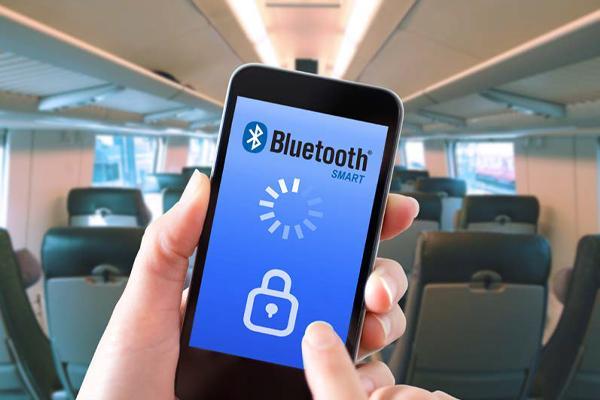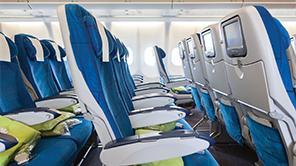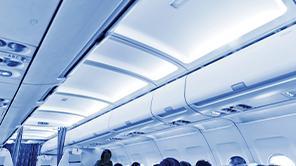Securing Passenger Belongings with BLUETOOTH® Access Control

In modern society where the latest technology is embedded everywhere, how can on-board security be left to chance?
Train travel is at its highest level since the 1980s, with an over 50% increase in ridership since the turn of the millennium.[1] With continued investment in the development of high speed rail networks, passengers are expected to travel further and more frequently as train travel has become a viable alternative to short-haul air travel for both business and pleasure.
However, security continues to present issues for rail networks, especially when it comes to protecting passenger belongings. In the UK alone, there were over 12,000 reported cases of personal property theft in 2015, including phones, tablets and laptops, as well as larger items including luggage and travel bags.[2]
On-board security remains limited; apart from video surveillance used on carriages and rail personnel, there are few measures in place to secure passenger belongings while travelling. Select operators provide a limited number of on-board lockers for stowing personal belongings, but these solutions typically cannot accommodate larger bags and feature basic mechanical locks that are exposed to tampering or manipulation.
With restricted space available, luggage racks are often installed at the ends of carriages or holdalls above passenger seating; furthermore, height and width limits restrict which items can be stored there. As a result, luggage is often left unsecured and out of sight at the end of the aisle, where travelers are reliant upon other passengers and the conductor to be vigilant in helping to prevent on-board thefts from taking place.
Electronic Access Solutions Enhance Physical Security
To alleviate security concerns, many carriers are beginning to investigate new solutions for controlling access to passenger belongings, such as on-board storage lockers equipped with electronic access solutions. Intelligent electronic locks provide a higher level of security and convenience with the added benefits of remote control and monitoring.
Electronic locking solutions offer a secure solution for rail carriers looking to eliminate common issues with mechanical locks, such as key management. When combined with an appropriate access control device, electronic locks can be easily networked into an existing infrastructure, and provide remote control and monitoring capabilities.
This digital record of access provides security personnel with a record of who has accessed a compartment, and when, which can be used to prevent unauthorized access. Electronically actuated rotary latches, for instance, offer a simple but versatile solution to achieve maximum security with a small design footprint. The latch is concealed on the inside of the frame and panel, taking up very little space – allowing increased locker capacity, and a clean, exterior surface free of visible pry points. Storage units with electronic locks can be designed into new trains, or electronic access systems can be retrofitted to existing storage lockers to replace or supplement an existing mechanical solution. This can be achieved without comprising on space or adding additional weight to the carriage.
To avoid jamming conditions in gasketed or heavily loaded compartments, electronic locking solutions designed with gear-motor driven mechanisms require less current to handle greater loads versus traditional solenoid-type locks. Incorporating high-quality, microprocessor-based motor-driven locks in storage locker designs allow these solutions to be precisely controlled and monitored for better performance and security.
Using your Smartphone as a Key
The rise of mobile and digital technology is changing access control. With embedded Bluetooth and 4G connectivity, manufacturers are using smartphones as a means of controlling access to cars and homes. This same technology can also be used to control access to storage units on-board the train that have been equipped with electronic locking solutions.
Traditional electronic access control is managed in one of three ways: through something you have (i.e., a key or RFID card), something you know (i.e., a PIN), or something that is uniquely you, such as a fingerprint. Smartphone based access provides for all three: one could argue that a person’s mobile phone, as it is used today, has become as unique to an individual as a biometric trait.
Bluetooth technology offers a user-centric, streamlined solution for the remote management of user credentials. When connected with cloud-based applications, Bluetooth-enabled devices – like the common smartphone – can be used as a key.
Electronic access solutions that integrate Bluetooth controllers offer a simple solution for on-board locker access. Time-based virtual keys can be sent wirelessly to a smartphone application via a cloud-based web portal. The passenger then simply opens the app to see their virtual keys, along with the associated locked equipment location, description and period of access time.
To access the locker, the passenger need only approach it and click the access button on their app, which transmits the encrypted Bluetooth signal to the reader, unlocking the door and sending a record of the access via the smartphone app to the cloud. With Southco’s BT BLUETOOTH® Lock Controller, the user does not need a wireless network to open the lock.[3] The mobile app simply communicates via Bluetooth, with the lock controller. At the same time, this technology also allows the rail carrier to monitor access to the storage wirelessly and remotely from any Internet portal, without having to connect to an existing security network.
Securing Rail Passenger Belongings with Bluetooth Access Control
Bluetooth technology can be utilized in the rail environment by incorporating the technology into the rail operator’s app environment or web portal, creating and managing the link between the customer and the locked compartment. Operators can use the technology as a new stream of revenue by charging per locker, per trip, and providing the purchaser with access to an on-board locker facility. Prices can be altered dependent on the length of the customer’s journey.
The access control system is easy to use from the customer point of view, and the connected electronic locking mechanism is highly responsive – there is no lag in the push-to-close mechanism when opening, allowing instant access to belongings. As a result, storage lockers equipped with electronic access solutions provide a secure means of improving physical security of passenger belongings without compromising the entry or exit areas of the train.
The Future of Rail Security
The advancement of digital technology continues to act as a major facilitator in the creation of electronic locking solutions that deliver enhanced customer convenience and security, which can help to propel the rail industry into the next generation of on-board security.
By incorporating intelligent electronic access solutions designed with Bluetooth technology into on-board storage lockers, rail operators can provide passengers with a safe, secure and comfortable travelling space where they can enjoy their journey without the hassle of having to worry about the security of their belongings. These intelligent electronic access solutions allow the rail operator to remotely track and control access to storage lockers, helping to reduce on-board theft while contributing to the bottom line via new revenue streams and value added benefits to passengers.
[1] Department for Transport – Rail Statistics
https://www.gov.uk/government/statistics/rail-passenger-numbers-andcrowding-on-weekdays-in-major-cities-in-england-and-wales-2015
[2] British Transport Police – Statistical Bulletin 2015-16 -
http://www.btp.police.uk/pdf/Stats%20Bulletin%202015-16%20Final%20 (1).pdf
[3] The BLUETOOTH® word mark and logo are registered trademarks of Bluetooth SIG, Inc. and are used under license.



